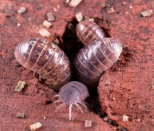You are using an out of date browser. It may not display this or other websites correctly.
You should upgrade or use an alternative browser.
You should upgrade or use an alternative browser.
Isopods
- Thread starter Orleander
- Start date
If they aren't poisonous...I'm sure someone somewhere eats them.
I think they are hard to fish for, and they get damaged easily in transport.
Approximately 4,500 marine species are known from all regions of the world's ocean, living most abundantly on the sea bottom from the abyss to the intertidal zone, and with only a few representatives in the pelagic zone. The group also has successfully colonized freshwater habitats (about 500 species) including lakes, rivers, streams, underground waters, thermal springs, the water held in certain tropical plants, and anchialine/cave habitats, where they often display associated specializations. All marine shorelines in the world are inhabited by species of the three very common families Idoteidae (Valvifera), Sphaeromatidae (Flabellifera), and Cirolanidae (Flabellifera). In offshore, soft-bottom, marine environments species of the suborders Asellota, Anthuridea, and Gnathiidea are very common. In the deep sea asellotans predominate almost to the complete exclusion of all other isopod taxa and, in fact, have undergone a massive evolutionary radiation in this environment (Wilson & Hessler 1987). Members of the suborder Anthuridea are slender, tubular forms that inhabit both shallow-water and shelf environments, and they are especially diverse in tropical reef habitats.
Approximately 4,500 marine species are known from all regions of the world's ocean, living most abundantly on the sea bottom from the abyss to the intertidal zone, and with only a few representatives in the pelagic zone. The group also has successfully colonized freshwater habitats (about 500 species) including lakes, rivers, streams, underground waters, thermal springs, the water held in certain tropical plants, and anchialine/cave habitats, where they often display associated specializations. All marine shorelines in the world are inhabited by species of the three very common families Idoteidae (Valvifera), Sphaeromatidae (Flabellifera), and Cirolanidae (Flabellifera). In offshore, soft-bottom, marine environments species of the suborders Asellota, Anthuridea, and Gnathiidea are very common. In the deep sea asellotans predominate almost to the complete exclusion of all other isopod taxa and, in fact, have undergone a massive evolutionary radiation in this environment (Wilson & Hessler 1987). Members of the suborder Anthuridea are slender, tubular forms that inhabit both shallow-water and shelf environments, and they are especially diverse in tropical reef habitats.
so....is that a yes or a no?
Yeah, basically. From Wiki:Hmmm! Woodlice!

(Emphasis mine)Giant isopods are of little interest to most commercial fisheries owing to the typical scarcity of catches and because ensnared isopods are usually scavenged beyond marketability before they are recovered. The species are noted for resemblance to the common woodlouse or pill bug, to which they are related. The few specimens caught in the Americas with baited traps are sometimes seen in public aquaria.
We used to call those bugs "rolly pollys" when I was a kid, for obvious reasons. (Or not - they tend to "roll-up" when touched, kind of like you might envision an armadillo behaving.)
Enmos
Valued Senior Member
Pill-bugs or Roly Polies are WoodliceOrleander said:woodlice? Must be a bigger version of roly polies or (as my Mom alls them) pill bugs.
Only some woodlice can do that though. Most can't.Randwolf said:We used to call those bugs "rolly pollys" when I was a kid, for obvious reasons. (Or not - they tend to "roll-up" when touched, kind of like you might envision an armadillo behaving.)
I checked Wikipedia and only the Woodlice from the genus Armadillidium can roll up into a ball.
So it seems you're not the only one that made the comparison with Armadillos
I never knew that. The ones that lived in Michigan and Ohio all pretty much exhibited this behavior. (As far as I knew, at least)Only some woodlice can do that though. Most can't.
I checked Wikipedia and only the Woodlice from the genus Armadillidium can roll up into a ball.
So it seems you're not the only one that made the comparison with Armadillos
They were quite common, all you had to do was turn over a log... Touch them, and Presto! A balled up bug. I guess they were all of that genus.
By the way, the comparison to Armadillos was purely my own conjecture, since I now live in Florida where such creatures are relatively common.
Wow. Someone else thinks like me...
A scary proposition.
so....is that a yes or a no?
Well, since I've never tried one before AND i'm allergic to iodine I think it would be better that I don't give them a try.
but that you know of, no one where you live eats them?
No, we eat crabs, shrimp and lobsters here mainly because we have an abundant supply so we don't want to go after those types of critters , at least not now. I can't eat shellfish so I just catch fish to eat for myself.
Enmos
Valued Senior Member
Wow. Someone else thinks like me...
A scary proposition.
Very scary indeed!
I've heard they were called 'cockroach of the sea'
Does that mean they are very plentiful or hard to kill. If they are plentiful, I saw we eat them
Did you ever taste one?
I say - Get 'em Orly! Get those marine lice and eat 'em up!I've heard they were called 'cockroach of the sea'
Does that mean they are very plentiful or hard to kill. If they are plentiful, I saw we eat them
If you devise any cool recipes, please share...
(For real)
This whole thread reminds me of Horseshoe crabs. I wonder if you can eat them?

We have an overabundance of these critters here in Florida...
This whole thread reminds me of Horseshoe crabs. I wonder if you can eat them?
I've read that those things are over 500 million years old! Would you eat something that aged? :shrug:



